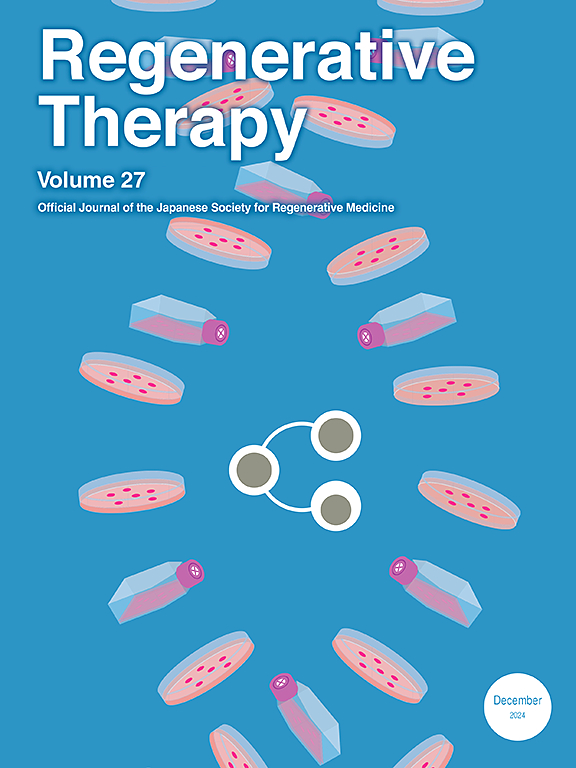Therapeutic potential of exosomes derived from human endometrial mesenchymal stem cells for heart tissue regeneration after myocardial infarction
IF 3.4
3区 环境科学与生态学
Q3 CELL & TISSUE ENGINEERING
引用次数: 0
Abstract
Myocardial infarction (MI) is the most common cardiovascular disease (CVD) and the leading cause of mortality worldwide. Recent advancements have identified human endometrial mesenchymal stem cells (hEnMSCs) as a promising candidate for heart regeneration, however, challenges associated with cell-based therapies have shifted focus toward cell-free treatments (CFTs), such as exosome therapy, which show considerable promise for myocardial tissue regeneration. MI was induced in male Wistar rats by occluding the left anterior descending (LAD) coronary artery. The hEnMSCs-derived exosomes (hEnMSCs-EXOs) were encapsulated in injectable fibrin gel inside the cardiac tissue. The encapsulated hEnMSC-EXOs were administered, and their effects on myocardial regeneration, angiogenesis, and heart function were monitored for 30 days post-MI. The treatments were evaluated through histological analysis, echocardiographic parameters of left ventricular internal dimension at end-diastole (LVIDD) and end-systole (LVID), left ventricular end-diastole volume (LVEDV), left ventricular end-systole volume (LVESV), and left ventricular ejection fraction (LVEF) and molecular studies. Histological findings demonstrated significant fibrosis and left ventricular remodeling following MI. Treatment with fibrin gel-encapsulated hEnMSCs-EXOs substantially reduced fibrosis, enhanced angiogenesis, and prevented heart remodeling, leading to improved cardiac function. Notably, 30 days after encapsulated hEnMSCs-EXOs were delivered corresponded with a less inflammatory microenvironment, supporting cardiomyocyte retention in ischemic tissue. This study highlights the potential of encapsulated hEnMSCs-EXOs in fibrin gel as a novel therapeutic strategy for ischemic myocardium repair post-MI. The findings underscore the importance of biomaterials in advancing stem cell-based therapies and lay a foundation for clinical applications to mitigate heart injury following MI.
人子宫内膜间充质干细胞外泌体对心肌梗死后心脏组织再生的治疗潜力
心肌梗死(MI)是最常见的心血管疾病(CVD),也是全球死亡的主要原因。最近的进展已经确定人类子宫内膜间充质干细胞(hEnMSCs)作为心脏再生的有希望的候选者,然而,与细胞为基础的治疗相关的挑战已经转移到无细胞治疗(CFTs),如外泌体治疗,这在心肌组织再生方面显示出相当大的希望。通过阻断雄性Wistar大鼠左前降支(LAD)诱导心肌梗死。henmscs衍生的外泌体(hEnMSCs-EXOs)被包裹在心脏组织内可注射的纤维蛋白凝胶中。给予包封的henmsc - exo,观察其对心肌再生、血管生成和心功能的影响,观察心肌梗死后30天。通过组织学分析、左室舒张末期(LVIDD)和收缩末期(LVID)超声心动图参数、左室舒张末期容积(LVEDV)、左室收缩末期容积(LVESV)、左室射血分数(LVEF)及分子研究对治疗进行评价。组织学结果显示心肌梗死后显著纤维化和左心室重构。用纤维蛋白凝胶包封的henmscs - exo治疗可显著减少纤维化,增强血管生成,防止心脏重构,从而改善心功能。值得注意的是,包封的henmscs - exo递送后30天,炎症微环境减少,支持缺血组织中的心肌细胞保留。这项研究强调了纤维蛋白凝胶中包裹的henmscs - exo作为心肌梗死后缺血性心肌修复的新治疗策略的潜力。这些发现强调了生物材料在推进干细胞治疗中的重要性,并为减轻心肌梗死后心脏损伤的临床应用奠定了基础。
本文章由计算机程序翻译,如有差异,请以英文原文为准。
求助全文
约1分钟内获得全文
求助全文
来源期刊

Regenerative Therapy
Engineering-Biomedical Engineering
CiteScore
6.00
自引率
2.30%
发文量
106
审稿时长
49 days
期刊介绍:
Regenerative Therapy is the official peer-reviewed online journal of the Japanese Society for Regenerative Medicine.
Regenerative Therapy is a multidisciplinary journal that publishes original articles and reviews of basic research, clinical translation, industrial development, and regulatory issues focusing on stem cell biology, tissue engineering, and regenerative medicine.
 求助内容:
求助内容: 应助结果提醒方式:
应助结果提醒方式:


